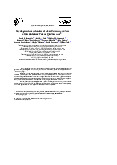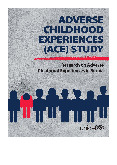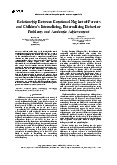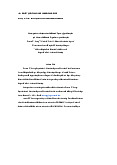



Preview text:
Adverse Childhood Experiences (ACEs) October 25, 2022
M What is it? Why is it being talked about? Types of ACEs (4, 5)
Adverse Childhood Experiences (ACEs) are
stressful or traumatic experiences that youth Abuse
LE are exposed to when they are under the age of Physical Abuse
B 18. These traumatic experiences can be Emotional Abuse
O related to abuse, neglect, or household Sexual Abuse
R challenges. ACEs can have an impact on
negative mental and physical health outcomes Neglect P throughout adulthood. (1-3) Physical Neglect Emotional Neglect
The two most reported ACEs are economic
hardship and parental separation or Household Challenges (6-8)
divorce, issues that are faced by many Incarcerated household Texas children. member Parental separation or divorce
The relationship between ACEs and food Mental illness in household insecurity is multi-faceted. ( 9 - 1 2 ) A parent’s Household substance misuse
mental health status, something that is Domestic Violence
categorized as an ACE, can subsequently
impact their ability to provide adequate food Other Adversity
for their child(ren). An accumulation of Bullying
multiple ACEs is associated with higher odds Poverty
of experiencing food insecurity. Food Community Violence
insecurity itself is associated with toxic stress – Natural disasters
the stress that is caused by other ACEs . (13, 14) How big is the problem? A
T The high prevalence of ACEs has been well documented, with up to 45% of children in the US
experiencing at least 1 ACE. (6, 8, 15) A
D In Texas, over 19% of children have experienced two or more ACEs before their 18th birthday. (16)
ACEs cause repeated activation of a child’s stress response, and with minimal stable
environments from trusted caregivers, a high ACE score can have consequences lasting well
beyond childhood. This can include changes in brain development, immune responses,
metabolic responses and how DNA is read and transcribed within the body. (3, 15, 17, 18)
As a result, adverse childhood experiences are associated with health conditions including mental and
behavioral health issues, decreased life expectancy, increased risk of viral infections, increased risk of
asthma, increased risk of teen pregnancy and sexually transmitted infections (STIs), and increased risk of
substance misuse in both children and adults affected by ACEs. (3)
People who experience 4 or more ACEs are: more likely to more likely to have more likely to have die by suicide Alzheimer's disease cancer, heart or Dementia disease, or stroke
ACEs-related illnesses are costly to families and communities. Economic losses due to ACEs can be in the
form of healthcare spending or lost wages from missed days of work, among others. ( 1 9 ) A 10% reduction
in ACEs would save approximately $56 billion annually in the United States. (15) S N Screening for ACEs
ACEs screenings completed by healthcare providers provide the IO
opportunity to identify adversities and ACEs and can capitalize on T
critical opportunities for prevention and intervention, such as
making referrals to family support programs. ( 6 , 2 1 )Additionally, ACEs
screening can strengthen patient-provider relationships through LU
increased trust and empathy. (20) O S
In communities where pediatric clinics are difficult to travel to, ACEs
and other trauma screenings have been implemented in school-
based health centers, underscoring the importance of providing
trauma-informed training to clinicians and educators. (20, 22) Raising Awareness of ACEs
Raising awareness of ACEs can reduce the prevalence of ACEs and their negative effects. This includes:
Providing trauma-Informed education for teachers, health care providers, and community members.
Trauma-informed education and healthcare assume that an individual is more likely than not to (23, 24)
have a history of trauma (including ACEs), acknowledge the role that trauma may play in a (25, 26)
person’s behavior, physical health, and life, and seek to avoid re-traumatizing them.
Training leaders of youth groups – such as faith-based groups, Boy & Girl Scouts, sports teams, and
recreational organizations – on how to notice signs of ACEs among kids in their community so they
too can avoid re-traumatizing youth under their care.
Promoting public education campaigns about ACEs. S (27) N Protective Factors Household-level IO
Enable caregivers to meet household basic needs of food, shelter, health services for children T
Strengthen families’ nutritional resilience through SNAP, WIC, and school meal programs
Expand access to necessary healthcare and mental health services through CHIP and Medicaid LU
Equip pediatric clinic and child psychiatry staff with resources for families/caregivers to work through
conflicts peacefully and build positive relationships with the people around them O S Community Level
Reinforce training of teachers and childcare, after-school, and extracurricular staff to create safe and
engaging environments by responding appropriately to conflicts or behavioral issues and modeling
positive coping and problem-solving
Support public education campaigns that encourage individuals to stay involved in their communities
Prepare for the successful implementation of referral programs by creating streamlined communication systems S Ethan Hunt, PhD, MPH
UTHealth Houston School of Public Health Austin Campus T R Melissa Peskin, PhD, MS
UTHealth Houston School of Public Health Houston Campus E
P Deanna M. Hoelscher, PhD, RDN, LD, CNS, FISBNPA
UTHealth Houston School of Public Health Austin Campus X Steve Kelder, PhD, MPH
E UTHealth Houston School of Public Health Austin Campus
Content development and research for this report were led by Dell Health Scholar Shelby Flores-Thorpe and TX RPC
Project Staff Emily Levin MPH, RDN and Kaitlin Berns, MPH, RD. For further information, please contact TXRPCNetwork@uth.tmc.edu.
S Connect with our team for more information on how TX RPC can help you. P TXRPCNetwork@uth.tmc.edu E T go.uth.edu/TXRPCProject S
T Explore our other health policy resources from public health experts on
X topics such as nutrition, food insecurity, mental health, and maternal
E and child health at go.uth.edu/TXRPCResources or scan the code. N S
E 1.Felitti VJ, Anda RF, Nordenberg D, Williamson DF, Spitz AM, Edwards V, Koss MP, Marks JS. Relationship of childhood abuse and
household dysfunction to many of the leading causes of death in adults. The Adverse Childhood Experiences (ACE) Study. Am J Prev C
Med. 1998 May;14(4):245-58. doi: 10.1016/s0749-3797(98)00017-8. PMID: 9635069.
2. CDC. Adverse Childhood Experiences (ACEs). Published 04/02/21. Accessed 10/18/22. N
https://www.cdc.gov/violenceprevention/aces/index.html
E 3.ACEs Aware. The Science of Trauma and Toxic Stress. Published 02/25/20. Accessed 10/18/22. https://www.acesaware.org/wp-
content/uploads/2019/11/ACEs-Aware-Science-of-Trauma-Fact-Sheet-2-25-20-FINAL.pdf
R 4.National Conference of State Legislatures. Adverse Childhood Experiences. Published 08/23/22. Accessed 10/18/22.
https://www.ncsl.org/research/health/adverse-childhood-experiences-aces.aspx
E 5.Safe Place to Learn. Adverse Childhood Experiences (ACE) Categories. Published 09/2016. Accessed 10/24/22. F
https://safesupportivelearning.ed.gov/sites/default/files/SP2L15%20Hndt_ACECategories.pdf
6. Rariden C, SmithBattle L, Yoo JH, Cibulka N, Loman D. Screening for Adverse Childhood Experiences: Literature Review and Practice E
Implications. J Nurse Pract. 2021 Jan;17(1):98-104. doi: 10.1016/j.nurpra.2020.08.002. Epub 2020 Sep 18. PMID: 32963502; PMCID: PMC7498469.
R 7.Sacks, V., & Murphey, D., Child Trends. The prevalence of adverse childhood experiences, nationally, by state, and by race or
ethnicity. Published 02/12/18. Accessed 10/24/22. https://www.childtrends.org/publications/prevalence-adverse-childhood-
experiences-nationally-state-race-ethnicity
8. National Survey of Children's Health, 2016. Accessed 10/24/22. https://www.childhealthdata.org/learn-about-the-nsch/NSCH
9. Baiden P, LaBrenz CA, Thrasher S, Asiedua-Baiden G, Harerimana B. Adverse childhood experiences and household food insecurity
among children aged 0-5 years in the USA. Public Health Nutr. 2021 Jun;24(8):2123-2131. doi: 10.1017/S1368980020002761. Epub 2020 Sep 1. PMID: 32867879.
10. Drexel University Center for Hunger-Free Communities. Adverse Childhood Experiences and Household Food Inseciruty. Published
11/2019. Accessed 10/18/22. https://drexel.edu/hunger-free-center/research/briefs-and-reports/aces-food-insecurity/
11. Drexel University Center for Hunger-Free Communities. The relationships between childhood adversity and food insecurity.
Published 01/2015. Accessed 10/18/22. https://drexel.edu/hunger-free-center/research/briefs-and-reports/relationship-between- childhood-adversity/
12. Chilton M, Knowles M, Rabinowich J, Arnold KT. The relationship between childhood adversity and food insecurity: 'It's like a bird
nesting in your head'. Public Health Nutr. 2015 Oct;18(14):2643-53. doi: 10.1017/S1368980014003036. Epub 2015 Jan 22. PMID: 25611561.
13. Testa A, Jackson DB. Adverse Childhood Experiences and Food Insecurity in Adulthood: Evidence From the National Longitudinal
Study of Adolescent to Adult Health. J Adolesc Health. 2020 Aug;67(2):218-224. doi: 10.1016/j.jadohealth.2020.02.002. Epub 2020 Apr 5. PMID: 32268998.
14. Hecht AA, Biehl E, Buzogany S, Neff RA. Using a trauma-informed policy approach to create a resilient urban food system. Public
Health Nutr. 2018 Jul;21(10):1961-1970. doi: 10.1017/S1368980018000198. Epub 2018 Feb 20. PMID: 29458445; PMCID: PMC6088531.
15. CDC. Fast Facts: Preventing Adverse Childhood Experiences. Published 04/06/22. Accessed 10/18/22.
https://www.cdc.gov/violenceprevention/aces/fastfact.html
16. Child and Adolescent Health Measurement Initiative. Texas Fact Sheet 2021: Strong Roots Grow a Strong Nation. Accessed
10/24/22. https://www.cahmi.org/docs/default-source/resources/2021-aces-fact-sheets/cahmi-state-fact-sheet---tx.pdf
17. Soares S, Rocha V, Kelly-Irving M, Stringhini S, Fraga S. Adverse Childhood Events and Health Biomarkers: A Systematic Review. Front
Public Health. 2021 Aug 19;9:649825. doi: 10.3389/fpubh.2021.649825. PMID: 34490175; PMCID: PMC8417002.
18. Finlay S, Roth C, Zimsen T, Bridson TL, Sarnyai Z, McDermott B. Adverse childhood experiences and allostatic load: A systematic
review. Neurosci Biobehav Rev. 2022 May;136:104605. doi: 10.1016/j.neubiorev.2022.104605. Epub 2022 Mar 9. PMID: 35278597.
19. Health Policy Institute of Ohio. Health Policy Brief: Economic Impact of ACEs in Ohio. Published 02/12/21. Accessed 10/18/22.
https://www.healthpolicyohio.org/adverse-childhood-experiences-aces-economic-impact-of-aces-in-ohio/
20. ACEs Aware. Benefits of Screening for ACEs. Accessed 10/18/22. https://www.acesaware.org/learn-about-screening/benefits-of-ace- screening/
21. Kia-Keating M, Barnett ML, Liu SR, Sims GM, Ruth AB. Trauma-Responsive Care in a Pediatric Setting: Feasibility and Acceptability of
Screening for Adverse Childhood Experiences. Am J Community Psychol. 2019 Dec;64(3-4):286-297. doi: 10.1002/ajcp.12366. Epub
2019 Aug 2. PMID: 31373039; PMCID: PMC6917888.
22. Guinosso S, Whitaker K, Dyer J. The Role of School-Based Health Centers in the ACEs Aware Initiative: Current Practices and
Recommendations. Published 01/2022. Accessed 10/18/22. https://www.acesaware.org/wp-content/uploads/2022/01/ETR-ACEs- Aware-SBHC-Practice-Paper.pdf
23. Hanson RF, Lang J. A Critical Look At Trauma-Informed Care Among Agencies and Systems Serving Maltreated Youth and Their
Families. Child Maltreat. 2016 May;21(2):95-100. doi: 10.1177/1077559516635274. Epub 2016 Mar 7. PMID: 26951344.
24. University at Buffalo Center for Social Research. What is Trauma-Informed Care? Accessed 10/18/22.
https://socialwork.buffalo.edu/social-research/institutes-centers/institute-on-trauma-and-trauma-informed-care/what-is-trauma- informed-care.html
25. National Education Association. Trauma-Informed Schools. Accessed 10/24/22. https://www.nea.org/professional-
excellence/student-engagement/trauma-informed-schools
26. Texas Education Agency. Grief Informed and Trauma Informed Practices. Published 12/08/20. Accessed 10/24/22.
https://tea.texas.gov/about-tea/other-services/mental-health/grief-informed-trauma-informed-practices
27. CDC. Risk and Protective Factors. Published 04/06/22. Accessed 10/18/22.
https://www.cdc.gov/violenceprevention/childabuseandneglect/riskprotectivefactors.html#Protective%20Factors



